#that's a reference to sleipnir
Text
there's something i love in particular about the silly 'barnabas sitting on his human lord commander like a horse' drawings other than just the fact that they exist but it's that as a horse sleipnir famously has six legs. right. and when they're fully primed odin is riding sleipnir. yknow. normally. like a horse. and with the leg around the big fucking belly and foot in a stirrup so odin's legs completely disappear into the silhouette
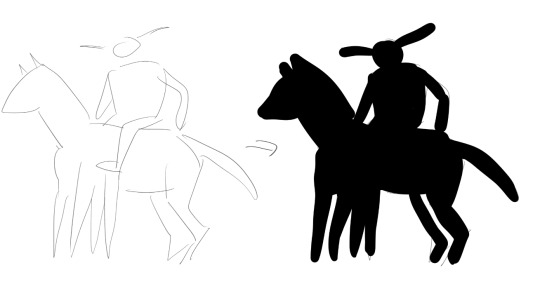
but if you do the 'human riding a human like a horse' then when barnabas is sitting on him. his legs completely reach the ground or at least close to it

therefore. turning. his own legs. into the third pair of legs in sleipnirs silhouette,
#spongesound.txt#it's art. it's poetry.#i was thinking about this last night but wasn't going to get up and draw the visual references sdkjfhgskjdfg#sleipnir harbard#barnabas tharmr#ffxvi posting
39 notes
·
View notes
Text
What if the Sleipnir's birth myth, but centaur-

#puppetmaster13u#ibispaintx#my art#centaur#loki#svadilfari#Sleipnir myth#loki mythology#norse mythology#character reference#Might make this into an actual comic
2 notes
·
View notes
Text
i need to replay sleipnirs scenes + fight sooo bad i cant get his cadence down 😭
#jupiter.speaks#❤️.sleipnir#> my (mental) notes on how he speaks is like. big arm gesture. says his majesty a lot. sassy + smug#> but that isnt enough eughghhh i need more like voice lines i can mentally refer to to build other sentences#> this sounds nuts whatever. writing life 😎
3 notes
·
View notes
Text
#sleip hc#this is your daily reminder that while i regularly refer to sleipnir as my sweet boy#my grumpy grandpa#my absolute favourite son#he is sad.#he is very hurt all of the time#and hes trying#sleips playlist#Spotify
0 notes
Text
CANTO 6 PART 3 SPOILERS
Im beyond pissed, tumblr crashed in the middle of me doing this so this is going to be so much shorter than I want it to be. NON RYOSHU RELATED POST ABOUT THE HEATHCLIFF. DON'T TAKE WHAT I SAY AS FACT I AM NOT QUALIFIED FOR THIS. LOOK AT THE LINKS I CITE FOR MORE INFORMATION! You can click them when their mentioned. Im not citing in the proper format. This was done on 5 hours of sleep, two eggs, and a box of banana milk.
youtube
The Erlkonig or Erlking is this figure in German Mythology who kidnapps children. When he touches you, he kills you. This poem made by Johann Wolfgang von Goethe then adapted to this song is what you see. Erlkoning Heathcliff is trying to intice Heathcliff to die by telling him that it's his fault Cathy is dead. All identities refer to the sinner as "child" when you look into their uptie stories. Mili and the singer of the video here use the same technique of changing the tone and pitch of their voice to differntiate two characters.
The Wild Hunt is a part of Norse Mythology where Odin, mounted on his sixed legged horse Sleipnir, goes through the forest. According to norse-mythology.org, anyone who gets caught up in The Wild Hunt, spotted or seen, gets carried away. Your soul will get incorporated into The Wild Hunt. We all know Erlking Heathcliff did, the rising of the bodies. The Wild Hunt is also mostly describe as having hounds, and who was a hound? Hindleys.
From the same website, on the page of Sleipnir reads,

Also, the horse that heath rides on has a weird liney pattern on it's 4 legs that kind of look like that runestone. There's more connection here, I just don't want to type it again.
How did Project Moon mix two diffrent mythological ideas together? (Its not just two, they mixed so many more.) Meet human mistranslation and the progression of oral tradition and story telling throught time. I don't kno where to start. There was mistranslation poem when, according to ancient-origins.net Johann Gottfried Herder wrote a seperate ballad from the one I linked at the start called Erlkönigs Tochter.
The Anglo-Saxons were early German settlers. This is where things get messy because I have several more potential leaders of the Wild Hunt but here are two, King Herla and Herne The Hunter.
Herne The Hunter: Popularized by Shakespeare potentially from a play called The Merry Wives of Windsor. This man called Jacobb Grimm said that Hene The Hunter was related to Odin. Herne the hunter is this ghost. ( https://mythopedia.com/topics/herne-the-hunter ) Im trying to say there are other media that connect the Erlking to the Wild Hunt but its on Wikipedia so it makes it seem fishy. Another Link Here


King Herla: A british king who attended a dwarf wedding. When he left the wedding, the world had changed. Unbeknowst to him, 300 years had passed and he was claimed to be missing. When his men tried to get off their horses, they turned into dust so they were stuck like that. Read it here, its short. Someone better and more credible than me summed the story up better than I did, historian Chrissy Senecal. Read right here. An additional link to cross refrence if you'd like. King Herla and Odin got conflated together when really, their diffrent people
I found this other website article about Wild Hunts which kind of brings me to the next thing, the Harlequinn. They weild clubs, their devils, the image of them is popularly joyful? Maybe goofy and lighthearted? Perhaps associated with cards? Matt, or Heathcliff's portrayal of Matt. Now, I'm looking at Wikipedia and I see this section.
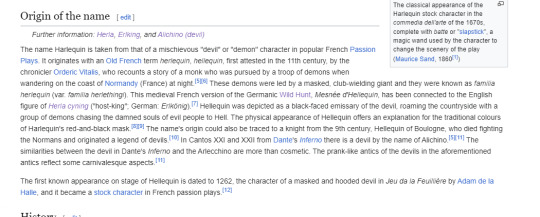
What do we have here? A mention of the Erlkönig, Dante's Inferno, masked, club weilding giant. Heathcliff's not giant but hes pretty tall, at least by my standards but whatever, im very short. DANTE'S INFERNO, Canto 11 and 12. What the fuck Project Moon, are you playing 5d chess?
Back on topic, Hellequin is the fairy king, and this figure pops up in German, French, Italian, and English folklore. I can't do proper research when all my search results are mixed with random junk and I'm becoming nutty. You will not normally be able to access this article without paying but here's the link anyways. Journal Article from this book on a section about horned deities made in 1922 speaks of a group of ghost riding, who are also huntsman.
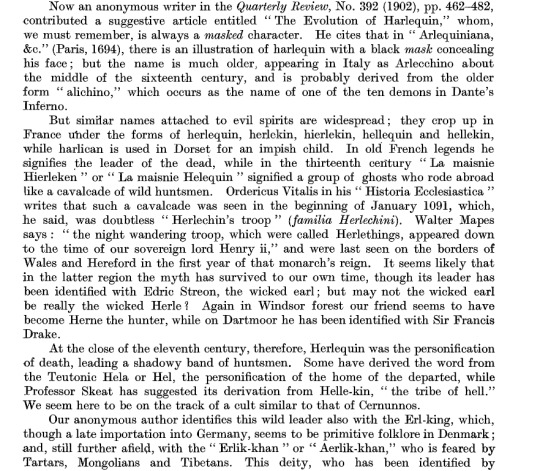
And also another mention of Dante's Inferno. The name, Herne The Hunter is mentioned again.
All and all, The link between The Erlkonig and The Wild Hunt isn't as wild and unexplainable as I originally thought. It's just so cool to see all these concepts intersect. There still so much to touch upon like the headless horseman refrence and the Dullahans, RYOSHU COMPARING THE WILD HUNT TO THE PARADE OF 100 SPIRTS, something along that line, I forgot the name. I'm just not the right person to yell about this but I will anyways. The writers mixed so many symbols of death into one character. Such a wild and nutty Canto. Thank you so much Project Moon.
#not ryoshu#not ryoshu related#limbus company#lcb heathcliff#a link between The Erlking and The Wild Hunt#canto 6 spoilers
50 notes
·
View notes
Text
Loki Deity Guide
Loki’s mythology is not as chaotic as you may think…
It’s even more chaotic than that!

Who is Loki?
Often referred to as the Trickster God of the Aesir, Loki is actually the son of Fárbauti a giant, or a Jötunn, and Laufey, who was said to be a goddess. Though Loki is often referred to using he/him pronouns, can change his shape and gender at will.
While many of the old stories involving Loki paint him in a negative light, the same cannot be said for Loki’s modern followers.
Parents and Siblings
Fárbauti (Father)
Laufey (Mother), sometimes referred to as Nál.
Býleistr (Brother)
Helblindi (Brother)
Lovers or Partners
Sigyn (Wife)
Angrboda (Lover)
Children
Nari or Narfi (from Sigyn)
Hel (From Angrboda)
Jörmungandr (From Angrboda)
Fenrir (From Angrboda)
Sleipnir (From Svadilfari)
Epithets
Loptr (Old Norse meaning “Air”)
Hveðrungr (Roarer)
Contriver of all fraud
Shape-Changer
Sly-One
Wizard of Lies
Thief of Giants
Evil Companion
Kinsman of Sleipnir
Foe of the Gods
Forger of Evil
Contriver of Baldr’s death
Wrangling Foe of Heimdallr
Notes
Loki was known to be mischievous and at times malicious, but he was also rather helpful in many stories.
At some point Loki’s name became conflated with Logi, meaning “fire”, however, Logi is a separate being and is the Nordic personification or god of fire. Many blame Richard Wagner for this mix-up.
It is also possible that Loki’s name means “knot” or “tangle”.
It has been debated whether or not the Finnish "Lukki" (the name for a spider with thing, long legs) came from the same root as "Loki" ("luka" the proto-germanic word for "lock") but this is not a very popular belief and there is very little evidence to back it up.
Though Loki is part Jötunn, he is seen as part of the Aesir.
My personal favorite story of Loki is Þrymskviða, in which Loki and Thor disguise themselves as women in order to get Thor’s hammer back.
Sleipnir, Loki’s son, is an eight-legged horse that came to be when Loki had to transform into a mare in order to drive away the great stallion, Svadilfari. While Loki was in the form of a mare, the two came together to create Sleipnir who was said to be the fastest and best horse in all of the nine realms. Odin eventually chose Sleipnir as his steed.
One of the most popular tales involving Loki gets its namesake from the god, the Lokkasenna.
Loki ends up punished by the Aesir for either killing Baldr or for the events that take place in Lokkasenna. He is bound in a cave by the intestines of one of his offspring, his son Nari is turned into a wolf, and a venomous snake is placed above his head and drips venom into his eyes. Sigyn holds a shell above his head to protect him from the venom but every so often needs to empty the shell and the venom drips into his eyes once more.
In myth, it is said that Ragnarök will begin when Loki breaks free from his bondage.
Loki has been conflated with Lugh, the Irish deity due to their similar prankster and chaotic nature as well as the slight similarity of their names.
Modern Deity Work
There is no evidence that Loki had a cult or large following until modern times, so many of these correspondences, offerings, etc are going to be based on Loki’s mythology and current Lokeans’ posts.
Correspondences
Rocks/Stone/Crystals
Bloodstone
Opal
Opalite
Pyrite
Herbs/Plants
Cinnamon
Birch (Loki is mentioned in the Norwegian Rune poem for Berkano/a, or Birch)
Dragon’s Blood
Mistletoe
Bentgrass “Loke’s Grass”
Dandelion “Loke’s Bloom”
Haircap Moss “Loke’s Oats”
Animals
Snake
Horse
Wolf
Spider
Salmon
Fly
Symbols
Snake
Air
Feathers
Kuanaz (Rune)
Berkano (Rune)
Offerings
Sweet foods
Sour foods
Cinnamon
Chocolate
Alcohol
Meat charred to ash
Mead
Acts of Devotion
Offering your time to Loki
Trying to understand the misunderstood
Don’t be afraid to go against the grain
Keep in mind that these are only some ideas for offerings and correspondences! Items and activities that connect you to her in a more personal way are just as good, and often better, than those you find on the internet. As with any relationship, feel it out, ask questions, and be attentive and receptive!
References and Further Reading
Loki - Britannica
Loki - Wikipedia
Loki - Norsemythology.com
Loki - Mythopedia
The Poetic Edda - translated by Henry Adams Bellows (Via Sacred Texts)
Loki in Norse Mythology - World History Edu
Symbols for Loki - Lokeanwelcomingcomittee
Loki Devotees and Followers to check out:
@lokeanwelcomingcommittee
@skaldish
@the-fox-jawed-witch
@jasper-pagan-witch
@broomsick
@grumpylokeanelder
@elizatungusnakur
as suggested by the community <;3
716 notes
·
View notes
Note
Could Alex Fierro from Magnus Chase kill macbeth? Alex is genderfluid and is *sometimes* a man. But also, Alex was born of Loki, who (in Magnus Chase) is also genderfluid and is usually a man, but Loki was a woman when Alex was born. Is the parent's gender at the time of birth the only thing that matters for the parent clause, or does the parent's current gender matter? Fun questions
For both the Gender Clause and Birth Parent Clause, the current gender is what we tend to take into account, especially when it comes to transgender characters ((sorry to all the trans men on that poll but I am going to validate your gender in the most soul-crushing way possible by telling you that, no, you couldn't kill Macbeth)). So a genderfluid character born from another genderfluid character is... an interesting situation, to say the least. In the past, when I reviewed Sleipnir (from Norse mythology), I said he counted for the Birth Parent Clause since Loki, though being genderfluid canonically ((god it's so funny to use the word canonically in reference to mythology)), is always always referred to masculinely, though it may very well be a different situation in Magnus Chase.
I'm going to say that Alex could kill Macbeth when they aren't a man and/or Loki is not a woman.
Thank you for your submission!
80 notes
·
View notes
Text
*At a sumbel, watching the host scrape a food offering into the bonfire while we all quip about not throwing the plastic plate into the flames along with the offering.*
Me: "I wouldn't put it past Loki to eat plastic."
Person A [in reference to the Sleipnir bit]: "Watch him eat it and shit out an ox."
Host: "Ah yes, the original 3D printer."
138 notes
·
View notes
Note
Okay, Norse fan here! What you need to know is: Odin is a piece of SHIT.
And if Vox was Loki's kid, HE IS IN DANGER.
All of Loki's children have suffered because of Odin:
Hela: Goddess of Death, but was made so because no one was ruling the underworld at the time and Odin just decided she got it and now half her body is continuously rotting.
Fenrisúlfr: is a ginormous wolf that is chained up with a sword through the top of his mouth because of prophecy say he'd eat and kill Odin. Now said prophecy will definitely happen.
Jörmungandr: gaint serpent that was thrown into the earth's oceans as a baby, now encircles the world: often referred to as the world serpent. Was thrown into the ocean because he kills Thor after Thor kills Fenrisúlfr in the Prophecy.
Sleipnir: Loki gave birth to this one: long story short, Thor promised something that wasn't his to promise (I think a Goddesses hand in marriage for finishing a wall?) So Loki shapeshifted into a Mare and led off the builder's magical stallion and a few months later appeared with an 8 legged foal that Odin took as his stead. (Also ALL of Loki's kids have human intellect...so.)
Narfi and Vali, his twin sons...these two are the saddest. Loki fucked up, and to punish him Odin used the twins. To do this he turned Vali into a wolf who then killed Narfi. Odin then used the intestines of both brothers to chain Loki to the ground where a snake dripped acid into his eyes.
So Odin probably killed Vox in the other anon's AU too, especially if he was Loki's favorite, and then to deny Vox respite in his elder sister's domain...like damn Odin. But Odin is an ass like that so.
I knew Odin was an ass but I didn't know it was this bad D: oh no! Alastor's wish to fight a god might come sooner than anticipated. I knew about the horse one because my sister likes to tell me about it and I knew Loki liked to change his gender around (we stan a genderfluid queen 💅🏻 I too am genderfluid so I love Loki) but I didn't realize how fucked up it was. Marvel are cowards for not having this be the true lore in avengers
23 notes
·
View notes
Text
HEL

WHO IS SHE?
Hel, also called Hella and Hela, is the name used to refer to the Goddess of the Underworld in Norse mythology. She is the daughter of Loki and the Goddess of death, disease, decay, and destruction. Hel is a mysterious, otherworldly deity who presides over the realm of the dead. According to the lore, her followers would be taken to her afterlife after death, where they would face their eternal fate. Though her domain is dark and seemingly frightening, Hel is a powerful and important deity in Norse mythology and has strong ties to the otherworld and the afterlife.
BASIC INFO:
Appearance: in Norse mythology, Hel is described as a very pale but beautiful woman, often with dark, pale hair. She is sometimes depicted as being very thin and gaunt, with a corpse-like appearance. She is also described as often being very sorrowful and sad, and she is known to be a rather ominous and sinister figure. She is often depicted wearing dark, gothic-style clothing and bearing a variety of symbols associated with death and the Underworld.
Personality: Hel is often described as being very sorrowful and solemn. She is often depicted as being a rather quiet and melancholy figure, lacking in the warmth and friendliness that is attributed to the other Norse goddesses. She is generally regarded as being a somewhat sinister and oppressive presence, and she is often seen as having a much darker and more brooding nature than her sisters.
Symbols: ankh, wolves, bones and skulls, ravens, corpse, scythe, fire, spiral, broom, rake, and Hagalaz Rune
Goddess of: death and the afterlife
Culture: Norse
Plants and trees: beech, alder, elm, ivy, juniper, willow, yew, nightshade, belladonna, datura, nettle, wormwood, elder, hellebore, mistletoe, and blackberries
Crystals: obsidian, amethyst, black onyx, bloodstone, jet, and black tourmaline
Animals: rats, wolves, crows, dogs, and serpents
Incense: myrrh, dragon’s blood, frankincense, and patchouli
Colours: dark green, black, dark blue, red, white, and dark purple
Tarot: Death, The Tower, and Suit of Swords
Planet: Pluto
Days: Monday, Halloween, Winter Solstice, Samhain, Helrbjörg, and Allhallowtide
Parents: Loki and Angrboða
Siblings: Fenrir, Jörmungandr, Váli, Narfi, and Sleipnir (Odin’s horse)
Partner: Baldr
Children: Krampus
MISC:
• Wolves: which are often seen as the guardians of the underworld.
• Ravens and crows: associated with the realm of the dead.
• Pluto: the planet associated with death and rebirth.
• Moon: is the celestial object associated with death, madness, and witchcraft.
• The wolf Gnaa, whose name translates to "the one of the deep" and is the guardian of the underworld.
• Helhest: a mystical three-legged horse that can run across the sky and the sea, carrying souls to the World of Death.
• The black dog Cegrim: which is said to guide souls to the land of Hel.
• The Norns: who are the three Goddesses who spin the fate of each individual soul.
FACTS ABOUT HEL:
• Holds a biconical horn, called a drink horn, which she uses to drain the souls from dead mortals.
• She is the daughter of Loki and Angrboda.
• Garmr (sometimes also called Garm) is the dog or hound that is considered to be Hel's guardian and protector in Norse mythology. Garm is a demonic and monstrous creature, with the size and strength of a bear, the aggression and cunning of a wolf, and the ferocity and loyalty of a dog. Garm is also immortal and has the unique ability to never sleep or rest, which makes him an incomparable guardian and companion to Hel.
• Bears the nickname Goddess of the Dead.
• She resides in a giant estate called Helheim.
HOW TO WORSHIP HEL:
To respectfully worship Hel, set up a sacred space dedicated to her and keep it organized and clean. Honor her symbols of death and rebirth with your attire, decorations, and rituals and rituals. Use colours associated with death and rebirth (black, dark purple, and dark green) in decorations and rituals. Light candles and incense during rituals and dispose of them responsibly.
HOW TO PRAY TO HEL:
To begin, you can address her by name and say something like:
"Hail Hel, Lady of the Underworld. I come to you seeking your guidance and protection. Please bless me with your wisdom and help me to walk the path of death and rebirth. Guide me into the realms of darkness, so I may emerge stronger and more enlightened.”
"Now that I have honored you and asked for your guidance, I offer this as a humble offering in your name. Accept my gratitude and blessings, and may our paths cross again in the future. Hail to you, Lady of the Underworld, I bid you farewell for now. Hail Hel.”
WHAT ARE SIGNS THAT HEL WANTS ME TO WORK WITH HER?
If your request to work with Hel has been accepted, here are some signs that you can look for:
• Feeling a sense of pull or attraction to her energy and teachings.
• Experiencing synchronicity or signs that point to her presence.
• You have dreams or visions about her.
• You hear/see her name on the TV, radio, online, in books, etc.
• You recently had a family member pass away
• You’re currently working on healing from religious trauma, specifically fears of death and Hell
• The Death card continually pops up in a reading
• Hagalaz rune is calling to you and showing up everywhere
• Hel’s animals are coming to you as a sign: dog, wolf, or horse
• An increased sense of devotion and reverence towards her.
• Feel drawn to her symbols or representations, such as skulls, bones, and Gothic imagery.
• Something in your life triggers an intense emotional or mental reaction where you feel a strong urge or desire to work with her and embrace her teachings.
• Experiencing a strong sense of passion, dedication, or devotion towards her.
If your request to work with Hel has not been accepted, you may notice the following signs:
• Strong sense of confusion, doubt, and disappointment.
• Intense negative feelings such as anger, frustration, or even guilt.
• Having a sense that something is off or missing, and a feeling of hopelessness and apathy.
• Feeling like your path is unclear, and a lack of direction and purpose.
• Lack of connection and familiarity with her energy and teachings.
Overall you need to be respectful of deities denying your request.
OFFERINGS:
• Money
• Jewelry with dark or gothic themes, as she is often depicted wearing such items in artwork.
• Precious stones
• Weaponry.
• Alcohol or other intoxicating substances.
• Herbs.
• Food or drinks: tea, soup, meat, honey, bread, milk, fruit, and other delicacies.
• Items that represent the cycle of life and death: such as bones, skulls, jewelry with a skeleton theme, and plants associated with death and rebirth.
• Fire or candles: associated with the realm of the dead.
• Music and instruments: she was said to be a talented musician and musician herself.
• Dried Flowers
• Blood
DEVOTIONAL ACTS FOR HEL:
• Keep a journal, record your thoughts and feelings about her.
• Create an altar or sacred space for her.
• Read or study books on Norse mythology and the goddess Hel.
• Pray to her and ask for her guidance and protection.
• Mindfully clean the graves of deceased loved ones. Talk to them when you visit. If you can’t visit your loved one’s graves, you can write to them and burn it. Watch the letter burn and think that the fire and smoke is delivering the message to them.
• Keep a small altar to honor your beloved who have passed and tend to it. Do not forget their names.
• Honour and embrace all of your emotions. This includes your negative emotions such as anger, jealousy, pain, etc. Accepting and acknowledging these emotions helps process them better and thus help you be a better person. Denying them allows them to fester.
• Do shadow work especially during Sundays.
• Do spirit work. Be cautious when you this and properly protect yourself and dismiss the spirit soon after.
• Do ancestral work and establish ancestral healing starting with you. This helps heal the ones who have come before you.
• Take time to sit in silence and watch the world move around you. You can do this in a symbolic way by leaving fruit like an apple outside and watch it rot.
• Meditate and learn the value of taking a pause in this fast-paced world.
• Accept change and adapt to it.
• Learn to appreciate the sudden changes or slight inconveniences in life. See the positive side of it.
• Learn the value of patience.
• Live your life as if it was your last (mindfully).
• Volunteer in cleaning cemeteries or in your local mortuary
• Keep a garden and care for it. (Some SDAs say she likes roses but she could ask you to care for other plants)
• Visit or volunteer in hospital work especially for the critically ill. Bring joy into their life even for a short while. You don’t know how much time they have left.
• Dress in neutral and dark colours.
• Dedicate a playlist for her.
• Collect animal bones. Clean then and breathe life into them (do so ethically, killing animals for bones is a blatant disrespect for Hel, the animal and the law).
• Adopt unwanted animals (the ones who are critically ill or are of old age) and give them the best life before they pass
• Carry an organ donor or a blood donor card.
• Enjoy fermented food and drinks such as wine and mead. Do not forget to toast to her name.
IS IT SAFE TO EAT OR DRINK AN OFFERING I GIVE TO HER?
It is not recommended to eat or drink offerings given to Hel because she is a powerful, protective, and guardian entity associated with the Underworld. She is a figure of death and rebirth, and she is responsible for ensuring the souls of the deceased cross over to the afterlife. Her energetic presence may not be fit for human consumption, and consuming offerings that were given to her may cause an imbalance in energy and a disruption in the connection with this deity. It is always better to err on the side of caution and avoid consuming offerings that were given to Hel.
#fyp#fypシ#fypシ゚viral#fypage#fyppage#tumblr fyp#satanist#satanism#deity#deity work#deity worship#occult#goddess#hel#norse mythology#death#underworld#information
19 notes
·
View notes
Note
I noticed that Pascal appears to have eight legs, is that inspired by Sleipnir at all?
nope! he has as many legs as he wants (or as many as i'm willing to draw)
the multiple legs/shiny body angle was actually heading towards the devil's coach-horse form i drew once, it was kinda going to be a mimicry thing - looks like it could be a horse? until it begins to devolve and spool out a little and then suddenly you're looking at, well,
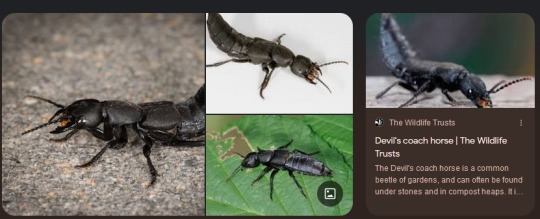
the surface of his body is referred to in-text/script as his carapace too. the fact that the coachhorse is also a mimic was what tied it in. they mimic scorpions, if you wave your finger over them they curl up their abdomen so it looks like a scorpion tail. everything being some form of mimickry, 'not what it seems', layers of that stuff. there was going to be a sort of ahh you got tricked moment, this guy is actually a horse is actually a horrible insect is actually a field of grain is actually a
you can see in the pascal sketchbook that there are a few beetle design elements in some of the supporting art too
HOWEVER... this is all older stuff which i decided to scrap! it wasn't gelling with my overall vision and strayed a little bit too far from what i needed & the original source material. also i was working with a lot of beetles at the time so i got influenced haha. those are still some of my favourite animals so i've been thinking of Bringing It Back but with a different character/new oc/whatever
#setting: inver#going for a much less 'scary monster ooh' vibe in the revamp... more atmosphere more weird tv show less What If Big Monster
87 notes
·
View notes
Text
Gotta love it when I'm watching Race to the edge and I hear the name of places and I think "hold on, that's a Norse myths reference." (Baldur, Sleipnir, etc)
20 notes
·
View notes
Text
anyway thinking abt homophobia in valisthea
which means thinking abt sex-related misogyny in valisthea. bc imo there is way too much sexual violence against women and focus on women as sexual figures w sexual drama in this game for it to not bleed over into how it feels abt two men kissing (not gonna go into a lesbian reading bc it exits my scope)
like. anabella only being a vessel for children, benedikta using sex to control titan/feel loved by barny but also being threatened w rape twice(?) by men, jill awakening shiva when she's almost raped by a man + other rosarian girls are raped, the constant winkwink sexy references w isabella, the offscreen women moaning in the oriflamme brothel, sylvester killing his wife n mistress after they outlived any sexual service to him, barny's mom referenced in an easily interpretable sexual manner, etc etc
simultaneously the narrative does its best to present the veil as a morally neutral institution w benefits to the function of northreach. the discussion between the male sex worker and the male guard was deliberately placed, too, and gives an interesting view into affection and money. theres a couple more men in veil garb that arent presented as out of place.
which is all failed by rest of the worldbuilding imo. only male customers visit the veil. sex is still regarded as a sneaky taboo subject. every country has a male monarch and occupations are firmly divided by gender. the primary hinge of benedikta's relationship w hugo is the fact that hugo feels in charge, which helps culturally ascribe dominance as a masculine trait.
if women are so widely regarded as unequal on sexual terms (and, relatedly, on societal terms), certain expectations must also exist on the male side.
we dont really see much tension in the male characters performing masculinity--other than the huge unnatural vibes sleipnir gives off by mincing around--but we do see barny kneel before ultima in a rly sexually charged scene. his subservience is presented as an unexpected weak facet of his character, where he's desperate and obliging and uncertain. it's a private scene that works off its own uncanniness, so it functions a little bit more as a narrative piece than a societal mirror. but I don't think that removes it from the discussion, and i think its odd character is a stark contrast to the clarity we're given in dion and terence's kiss scene.
a sort of clarity, i guess. dion and terence talk abt power dynamics in class instead of sexual role or gender. there's still the words 'master' and 'servant' pinned on the wall w like 3 different undertones, so its easy to unravel that into different understandings of their relationship to class, duty, and romantic/sexual identity. i dont think its productive to split hairs abt who tops, but i think its reasonable to interpret that they feel secure in w/e service they give to the other. this is in spite of the societal understanding that dominance is inherently masculine and correct, and that subservience is feminine and not as acceptable.
i know enough abt queer history to know that the security & fulfillment i interpret them as having is simultaneously as rare as it is common depending on where you look. no matter what one does in the private sphere, the public view will influence it, and it's determined by the case who will feel negatively or positively abt themselves bc of it.
ultimately i see valisthea in the respect of a society that views queerness as undesirable but not smth ur gonna be burned at the stake for. im also fully operating under my own preference for queer narratives that labor under external & internal homophobic conflicts. it's fully supportable to decide that valisthea lacks homophobia as well, and its not less like wish fulfillment to have it that way or the other.
#this is all to say that while i see and acknowledge the 'security' i describe in teredio#that im ripping it away from terence HGTGDGJGTHJYGRHVFG#SORRYYYYYYY i want him to think abt being an invert when society is not built for that lol#brihamut's mercy
23 notes
·
View notes
Text
barnabas + sleipnir and kosmos are like what if you saw the worst parts of me and still loved me. what if u thought the only to save urself was to save others. what if u were drowning in the past and ur own wrongs and even the wrongs of others. what if you wanted so desperately to be saved when no one else could or would, not even ur god. what if there was someone, anyone, else in your corner for the first time in years. what if there was love, even when, by all accounts, there shouldnt be! what if love changed everything - not just for you but for the world!!!!!!
meanwhile enver and artifurge is like what if we made each other worse lol
#jupiter.speaks#❤️.barnabas#❤️.sleipnir#👤.kosmos#> no there is depth to enver n arti i just need to put it into thoughts shsbjdndjd#> i also dont know if this needs taggin bc of barny n his religion issues so. eughgh#> and YES. maybe im reading too much into it whatever !!!!!!!!!! i know im right#> also i wont explain which is referring to who. its whoever u think and also whoever u dont think.
2 notes
·
View notes
Text
IBO reference notes on . . . odds and ends
I have begun writing another big notes entry but it's a heavy one and requires visuals, so I suspect it'll be a while before it's done.
In the meantime, here are a few jottings on various random things in Iron-Blooded Orphans I thought worth commenting upon.
Naming conventions
The headline one, obviously, is the Gundams being named for the demons listed in the Ars Goetia. This we eventually discover is an in-universe response to the naming convention used for the mobile armours the Gundam frame mobile suits were developed to take down. Each mobile armour is named for a angelic figure: Hashmal is named for a class of angel while Harael, Mebahiah, Nemamiah and Ananel are all apparently derived from the Shem HaMephorash. It would be neat if all the names came from John Reuchlin's list of 72, which corresponds directly to the goetic demons but Hashmal nixes that idea.
It's also unclear if the names are for individual units or if they represent different lines or categories of armours. I tend towards the latter, simply based on the scale at which the Calamity War is presented as happening. This is somewhat tenuously is backed up by the Iron-Blooded Orphans G mobile game (RIP) presenting the player with a battle against 'Ananel Alpha' and the flashback in the Urdr Hunt campaign seeming to show Gundam Marchosias fighting a pair of Haraels. Though I must admit, I've watched that clip a few times and still cannot quite make up my mind it if represents two Haraels or just the multiple perspectives of Harael's claw eyes.
In any case, it seems that whoever named the Gundams had enough sense of drama to designate their 'angel hunters' as actual demons. And yet, the overall organisation that operated them -- Gjallarhorn -- embraced quite a different tradition.
This was of course Norse mythology. Each family in the Seven Stars ruling council has heraldry based on a different beast from the sagas (Odin's Ravens, Fenrir, Sleipnir, Jörmungandr, Nidhogg, Veðrfölnir (probably), and Ratatoskr). They have bases named Vingólf and Gladsheimr. Their mobile suits are derived from a set of machines named after Wagnerian valkyries, and they designate various different types of 'suit using German words. And of course, 'Gjallarhorn' itself is the name of the horn that sounds the start of Ragnarök (fitting, for a group formed to prevent the apocalypse). Plus, you know, there's Vidar's whole deal.
Curiously, there is an additional use of a Norse name in the setting: the Garm Rodi, a seemingly unaffiliated type of mobile suit primarily seen in use by the Dawn Horizon pirates. Given this is an instance of mythological naming in a line that otherwise has prefixes like 'Spinner', 'Landman' and 'Monkey', I wonder if perhaps this indicates the type of machine used by Gjallarhorn prior to the development of the Valkyrja and Gundam frames (these both belong to the late Calamity War period, whereas Rodis were deployed during the middle period; no we have no idea how long each period lasted). I haven't any particular reason for thinking this beyond it being named for the dog that guards Hel, but given Norse names are otherwise entirely restricted to Gjallarhorn, it would almost be weirder if there wasn't a connection.
(The Garm is also noted for its versatility, which puts it in the same bracket as the general-purpose Graze frame that has become Gjallarhorn's mainstay.)
Speaking of mobile suit lines, the Hexa frame stands out for having different types designated using people's names: Hugo, Gilda and Enzo. A quick web search for the three names in conjunction returns the Argentinian film Una Cita con la vida, directed by Hugo del Carril, starring Gilda Lousek and Enzo Viena. I do not know if there is any connection there, out of fiction, but it struck me as an intriguing coincidence.
Then we have Teiwaz naming their mobile suits using romanised Japanese words: Hyakuren, Hyakuri, Rouei, Shiden, Hekija. Not much to say about that, since it fits exactly with their Japanese/Italian fusion mafia aesthetics. Although, I suppose we should shout out the Chief's bonkers suffixes. Lupus Rex? Rebake Full City? Jeepers.
Finally, I'd like to draw attention to how the Ariadne Network fits into all this, or rather how it doesn't. It's named for the myth of the Minotaur and how Ariadne gave Theseus a guiding thread to help map his way through the labyrinth. Fitting for a network of navigation beacons. However, as a piece of technology, it's an outlier, named for a Greek myth despite being under the control of Gjallarhorn.
The implication is that the Network predates both them and indeed the Calamity War, with the use of Ahab reactors in its construction being cited as a cause of said War, by virtue of preventing long-range communication and observation. Should we therefore take from this that pre-Calamity War devices follow a Greco-Roman naming convention ala the US space program? There are other Greek names used in the setting, specifically for the regions into which Mars is divided, following the actual real-world mapping of the Red Planet's geography, so I wouldn't want to rule out such a conclusion -- particularly with the way English is used in the setting. But on the other hand, it could simply be that the Network's function made this particular allusion irresistible.
Currency
There are two canonical currencies: the galar and the meria. As far as I can tell, the galar is exclusively mentioned in the context of Mars, and is therefore presumably related to Gjallarhorn's rule of the planet. Meanwhile the meria is used in the two spin-offs, Moon Steel and Urdr Hunt, both of which take place on or around space colonies. Whether this means the meria is primarily a space-based currency, or just a widely used currency in general is unclear.

Mostly I just think this is worth noting for the potential implications the galar has for Mars' situation: if the money in circulation there is directly controlled by Gjallarhorn, then that represents an added obstacle to independence. And given so much of Kudelia's efforts are focused on achieving greater economic freedom from Earth, it's an interesting detail to consider.
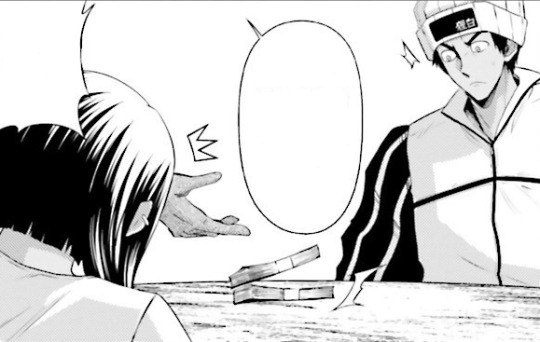
Oh, and apparently paper-like money is still in vogue in the Post-Disaster timeline. Which seems a bit odd, since paper itself is counted as a marker of wealth (explicitly stated in the translation of the CGS promo website linked from Gundam wiki; implied in the series by things like how we only ever see real books in the hands of the upper classes).
In Moon Steel, Tanto Tempo's members use paper files and documents, presumably because being part of an Earth-adjacent company, they can afford it. This makes me wonder about the source of the material. Do space colonies grow and recycle their own paper? Is that another layer to money's value in this setting? Or is the case made from some other material?
Food for thought, at least.
This excavator
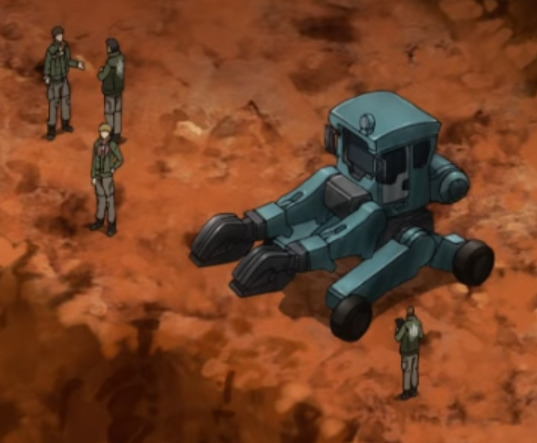
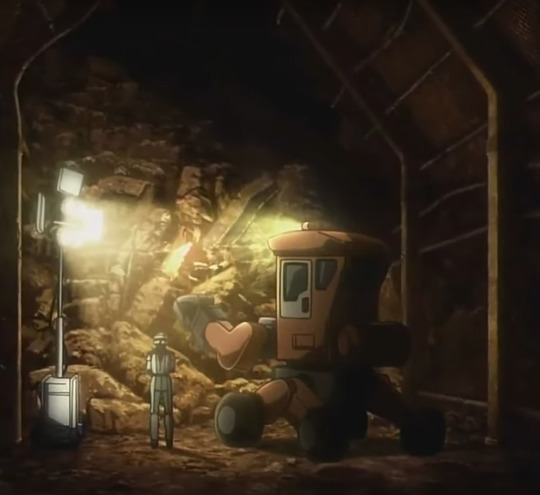
Because first of all, it's an adorable piece of design work. And second, it's a rare example of non-mobile suit robotics in the setting.
Most Gundam shows have some sort of 'sub-mobile suit' category of mecha, be that a cruder precursor to the humanoid robot suits that are the mainstay of the franchise or a more utilitarian, often civilian variety of machine used for maintenance and construction work. Iron-Blooded Orphan's mobile workers are, however, mostly seen in military configurations, operating as small, extremely manoeuvrable tanks. I don't think it's too much of a stretch to classify them as mecha in their own right -- they have moveable 'legs' and on the type Tekkadan uses at least, the cannons operate in an arm-like fashion. But overall, they are generally more tank-like than anything else. The only civilian use we see from them is as a flat-bed truck. Indeed, when construction work in the space colonies comes up, it is specifically mobile suits that are cited as being used.
This excavator, which shows up in the background of the main series and has very slightly more presence during the Urdr Hunt game, makes it clear there are in fact mobile worker-like machines with entirely non-military uses. The arms appear to articulate in ways that set it apart from a real-world excavator, suggesting it operates in a more human-like fashion than your average JCB, and the armatures holding it up resemble mobile workers, only in a more stable four-point layout than the otherwise ubiquitous tripod arrangement.
It's a nice touch, extending the sci fi conceits throughout the world-building. It also stands out because so many of the vehicles shown beyond the obligatory humanoid mecha are simply . . . mundane. The cars, trains and even the fighter jets are little different than those we'd see around us today. Having something like this show up helps avoid the sense of the mobile suits being fantastical devices with no connection to the rest of the technological landscape, and gestures at mobile workers having uses that would earn them that name.
Gjallarhorn's plastic macs

I just love how utterly dorky the official rain-wear is.
McGillis very much doing the 'dignity, always dignity' bit, there.
Other reference posts include:
IBO reference notes on … Gjallarhorn (Part 1)
IBO reference notes on … Gjallarhorn (Part 2)
IBO reference notes on … Gjallarhorn (corrigendum) [mainly covering my inability to recognise mythical wolves]
IBO reference notes on … three key Yamagi scenes
IBO reference notes on … three key Shino scenes
IBO reference notes on … three key Eugene scenes
IBO reference notes on … three key Ride scenes
IBO reference notes on … the tone of the setting
IBO reference notes on … character parallels and counterpoints
IBO reference notes on … a perfect villain
IBO reference notes on … Iron-Blooded Orphans: Gekko
IBO reference notes on … an act of unspeakable cruelty
IBO reference notes on … original(ish) characters [this one is mainly fanfic]
IBO reference notes on … Kudelia’s decisions
IBO reference notes on … assorted head-canons
IBO reference notes on … actual, proper original characters [explicit fanfic – as in, actually fanfic. None of them have turned up in the smut yet]
IBO reference notes on … the aesthetics of the mobile frame
IBO reference notes on … mobile suit designations
IBO reference notes on … the Gundams (part 1)
IBO reference notes on … the Gundams (part 2)
IBO reference notes on … the Gundams (part 3)
IBO reference notes on … the Turbines, or ‘Tekkadan done right’
IBO reference notes on … the Gundams (Addendum 1)
IBO reference notes on … deals with the devil
#gundam iron blooded orphans#gundam ibo#g tekketsu#tekketsu no orphans#reference#notes#I will probably do more posts like this at some point
12 notes
·
View notes
Note
In the first avengers film Loki's costume featured a wolf and a snake as reference to his children fenrir and jormungandr in norse mythology. I think it's a real shame that he never got a costume that had half skeleton motif to reference Hel
or a horse, for sleipnir. and poor narvi just gets left out of the easy symbolism gang. because the main imagery that comes to mind when i hear "narvi" is a little gruesome 💔
36 notes
·
View notes